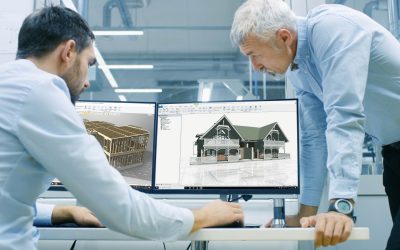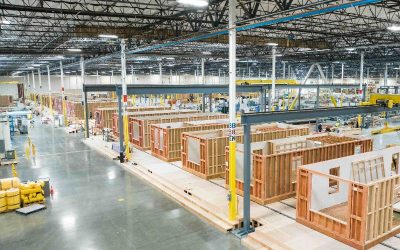Vertex BD Startup and Implementation — Blog 3: How Vertex BD Helps Designers, Builders, and Owners
McKinsey describes digital transformation (DT) as “the rewiring of an organization, with the goal of creating value by continuously deploying tech at scale.” DT is challenging for any business process, be it accounting, recruiting, compliance, or any other.
- Blog Post
- November 2023

- Pekka Moilanen
- Marketing Director
But the risk and complexity increase when organizations implement DT in their core operations and technical functions. This is the case for property owners and architecture, engineering, and construction (AEC) firms selecting and implementing a building information modeling (BIM) software platform.
A capable BIM platform digitizes the core functions of all the stakeholders involved. It’s not just about optimizing a discrete business process or set of tasks — the software becomes the primary medium through which all project stakeholders interact with the design until the building is completed.
With so much riding on this decision, it’s important for AEC firms to understand the capabilities of each platform they consider and how the software will be implemented at scale.
In this blog, I explain the most important features and characteristics of the Vertex BD BIM platform and how it helps stakeholders in all three facets of the industry achieve DT.
Let’s start with a key concern for every company that adopts BIM: implementation.
Hassle-Free Implementation
Selecting and implementing a BIM software platform is a major decision that has a profound impact on your firm’s future success. Return on investment (ROI) in the form of increased efficiency and reduced labor costs and errors is the long-term goal for most companies adopting BIM, but the short-term goal should be an efficient and hassle-free implementation process.
Vertex supports our customers from the beginning of the implementation process by providing detailed video tutorials to guide them through the initial steps. As their skills progress, customers can follow the Vertex YouTube channel to broaden their skills and learn about new features and updates.
Once the software is installed, Vertex makes it easy for our customers to move their past and current projects into the platform by ensuring compatibility with all commonly used design file formats. Customers can easily import 3D models and 2D drawings in more than 20 formats, including IFC, PDF, 3D PDF, DWG, DXF, IGES, STL, and many more.
Providing our customers with clear documentation, informative videos, and highly compatible software ensures that they can quickly benefit from their technology investment.
Now let’s discuss how Vertex BD helps professionals across the AEC industry.
Vertex BD for Designers
For design applications, Vertex BD saves time by eliminating manual drafting tasks. For example, Vertex BD enables architects and engineers to accelerate design and production by including time-saving drafting features and tools for creating building components.
When a designer creates a 3D model, the platform automatically generates framing details, panel fabrication drawings, and tools for creating floor, wall, ceiling, and roof framing layouts.
The software also includes features to support structural engineering applications, such as cold-formed steel truss design based on AS/NSZ, Chinese, and Eurocode standards.
Automatically creating a complete and consistent set of documentation saves architects and engineers a great deal of time and reduces the possibility of human error and costly re-work on site.
Vertex BD for Builders and Contractors
Vertex BD also saves time and improves outcomes for construction and manufacturing operations. The software improves preconstruction processes by providing built-in features for estimating and generating shop drawings. It can also generate bills of materials, window and door schedules, and cutting lists for error-free fabrication.
Vertex improves planning capabilities and jobsite safety through improved visualization, made possible by advanced 3D and VR modeling. Contractors and subcontractors have the opportunity to virtually experience the space in advance, which is useful for work sequencing, scheduling material deliveries, and proactively addressing safety concerns.
In manufacturing and industrialized construction environments, Vertex BD’s CNC Manufacturing Interface can send fabrication data from the software directly to manufacturing equipment, eliminating the possibility of manual transcription or programming errors. The CNC Interface is compatible with a wide range of fabrication equipment.
Vertex BD for Owners
Project owners may be the biggest beneficiaries of Vertex BD, because the software greatly accelerates and improves the design and construction phases of the project.
From the outset of the design process, the 3D and VR models generated by Vertex BD provide a clear and understandable vision of what the building will look like and how it will be situated on the specific site. This helps owners and architects avoid delays in the design process caused by misunderstandings or differing assumptions about a given aspect of a building.
Enhanced communication and coordination, reduced errors, improved jobsite safety, and fewer avoidable delays are all major positive impacts enjoyed by owners of projects designed with Vertex BD.
Ready for Digital Transformation?
If you’re ready to take advantage of DT and accelerate your projects, request a free trial of Vertex BD. Our software is helping companies around the world build amazing projects faster, safer, and more profitably than ever before, and we would love to help your company make the jump to BIM.
Feel free contact our sales or me through LinkedIn if you have any questions about Vertex BD.
In my next blog, I’ll discuss specific use cases for Vertex BD in different sectors. Stay tuned!
Related Stories
Best 3D construction software for professionals
Best 3D construction software for professionals 3D construction software has become a cornerstone of modern building projects, fundamentally transforming traditional construction practices. By enabling architects, engineers, and builders to create highly detailed,...
Leading construction design software for professionals
Leading construction design software for professionals In the ever-evolving construction industry, construction design software has become indispensable for streamlining workflows, enhancing accuracy, and improving collaboration. Among the available options, Vertex BD...
What is modular building design? – Unlock efficiency and precision
To fully unlock the potential of modular building design, it’s essential to utilize advanced tools that streamline the process from design to construction. While modular construction already offers significant advantages like faster timelines and cost savings, a tool like Vertex BD takes it further by integrating design and manufacturing into one seamless platform.




